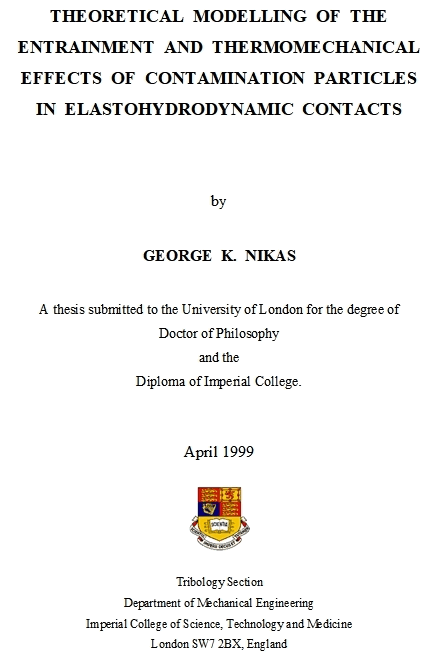
Theoretical modelling of the entrainment and thermomechanical effects of contamination particles in elastohydrodynamic contacts

Ph.D. and D.I.C. thesis by George K. Nikas
Imperial College London, Department of Mechanical Engineering, Tribology Group
Exhibition Road, London SW7 2AZ, England
Academic supervisor: Dr Richard Sayles (Imperial College London, Mechanical Engineering Department)
Industrial supervisor: Dr Stathis Ioannides (SKF-ERC (Holland) and Imperial College London)
Download a PDF copy of this thesis (5.4 MB)
This thesis was submitted in 1999. It can be found in
the Mechanical Engineering Department Library of Imperial College London;
Thesis statistics: 342 pages; 114 figures; 323 detailed equations; 18 tables.
Related
computer software
Program PhD. Thermoviscoplastic effects of solid contamination particles in rectangular, rolling-sliding elastohydrodynamic contacts. Three-dimensional subsurface elastic stress analysis; surface thermoviscoplastic displacements in concentrated contacts from squashing of ductile debris particles; analysis of frictional heating and flash temperatures; particle entrapment analysis for rolling-sliding line contacts; analysis of the formation of tribochemical surface layers as a result of dynamic thermal effects. Calculation of dynamic particle forces, mean friction coefficient of the contact, plastic work and power (energy consumption) to squash a particle. The program is written in Fortran. Code length: 4232 lines. Latest version: 7.5.5.
Program SKF. Solid particle entrainment and entrapment analysis in elastohydrodynamic, rolling-sliding, rectangular (line) and circular (point) contacts. Program written in Fortran. Code length: 798 lines. Latest version: 1.4.1. [Related project]
Program TRAJECTOR. Computation of the trajectories of disc-shaped solid particles trapped in bearing contacts. Written in Fortran. Code length: 232 lines. Latest version: 1.1.2. [Related project]
ABSTRACT
The basic aim of this work was the theoretical investigation of the mechanisms of entrainment and elastoplastic compression/shearing of soft/ductile contamination particles in sliding-rolling elastohydrodynamic contacts. In pursuit of this target, two models were developed to study the entrainment process of spherical particles in the inlet zone of lubricated point contacts and the mechanism of thermomechanical deformation of soft/ductile spherical particles in the inlet and central (Hertzian) zone of lubricated line contacts. The models were materialized through computer simulations to analyse a large number of typical applications and to cover a broad range of operating conditions, representative of industrial Machine Elements (gears, bearings, etc.). The simulation revealed the risks involved in the presence of soft contaminants in concentrated contacts. More specifically, contamination particles were related to surface indentation, scuffing/seizure (directly or indirectly), as well as thermomechanical wear (local high-heat tempering reactions and even melting). The models are aimed to predict clearly the onset of damage due to the presence of one or more, mainly soft/ductile and metallic, contamination particles in concentrated contacts and to predict the critical values of operational parameters such as the slide/roll ratio, film thickness, thermomechanical properties of the materials involved, etc., which would produce an unsafe working environment, in the presence of specific solid contaminants. The assessment of the risk of damage was both short-term (surface indentation, abrasion and scuffing caused by lubricant starvation due to inlet blockage by debris) and long-term (fine pitting and residual stresses due to the plastic indentation of debris, which would extend to gross damage, or small thermo-cracks caused by the frictional heating of debris, which could later propagate under the action of high solid or lubricant pressures). Results are verified by comparison with experimental findings from the literature and new hypotheses are put forward to explain some reported failures or to point experimentalists to specific areas of future research.
Publications of the author related to this thesis (most recent first)